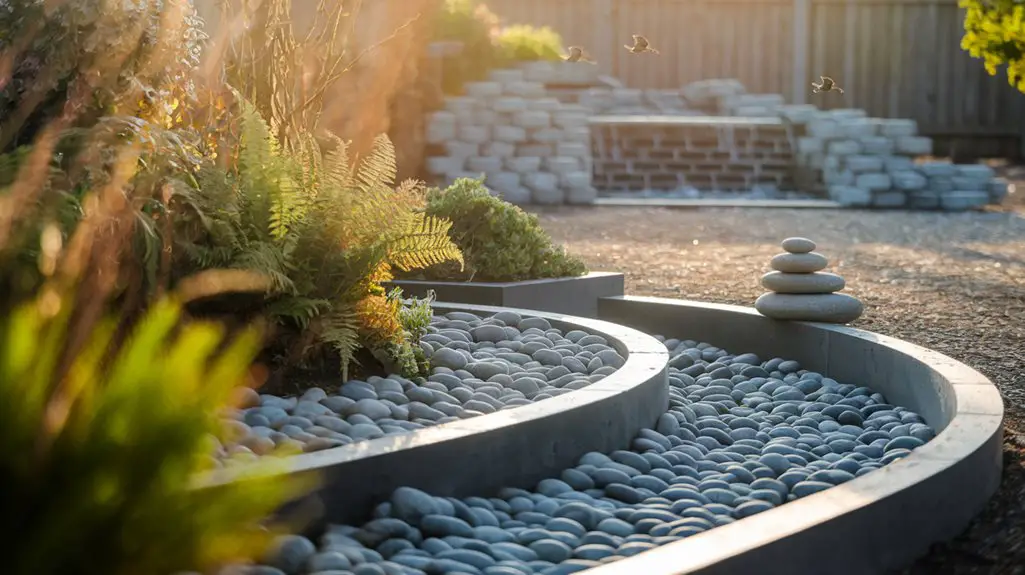Imagine the crisp, invigorating allure of a wildlife pond on your property, nurturing biodiversity while serving as a slice of nature's complexity. Constructing such an ecological marvel begins with selecting an ideal location, followed by designing a conducive shape and size. You'll choose materials that respect environmental integrity, and planting native species to support diverse organisms. But how do you maintain this living habitat, ensuring equilibrium and sustainability? Explore further to discover nature's secrets.
Selecting the Ideal Location
Selecting the right spot is vital for the success of your wildlife pond. Prioritize locations with partial sunlight; aquatic flora harness photosynthesis effectively in such conditions.
Additionally, proximity to existing natural elements like shrubs or trees can offer shade and organic matter contributing to the pond's ecological balance. However, beware of excessive tree cover, which may lead to nutrient overload from leaf litter, impacting water quality.
Consider the pond's proximity to a water source for ease of maintenance and ecological resilience. Observing natural drainage patterns will inform surface runoff implications, important for preventing pollutant ingress.
Assess the soil's permeability—loamy soil supports proper hydrological stability. A suitable location aligns with the life cycles of target fauna, fostering biodiversity and ensuring ecological functionality. Furthermore, incorporating native plant species can enhance the pond's attractiveness to wildlife and promote a healthy ecosystem.
Designing the Pond Shape and Size
Crafting the pond's shape and size requires meticulous planning to guarantee ecological harmony. When designing your wildlife pond, consider the following guidelines to promote biodiversity and sustainability:
- Size Analysis: Evaluate the space available and your pond's intended function. A 1 to 5 square meter pond can attract diverse fauna while maintaining ecosystem stability.
- Shape Consideration: Non-linear shapes with curves and edges create microhabitats, promoting species richness by varying conditions like sunlight exposure and water depth.
- Depth Variability: Incorporate shallow and deep zones. Shallow areas around 15-30 cm support plants and amphibians, while deeper sections of 60 cm+ accommodate overwintering species.
- Gradual Slopes: Ascertain sloping edges with gradients of 1:3 or 1:4 to provide safe access for terrestrial wildlife.
Additionally, creating a habitat for beneficial insects can enhance the ecological balance of your pond environment. Implementing these principles fosters a balanced aquatic ecosystem, optimizing wildlife habitation.
Choosing the Right Materials
To build a successful wildlife pond, selecting appropriate materials is essential for ensuring both durability and ecological compatibility. You should begin by evaluating various pond liners, primarily focusing on their permeability and resistance to ultraviolet radiation.
Ethylene propylene diene monomer (EPDM) is a robust choice due to its elasticity and longevity, minimizing leaks that could disrupt the habitat.
Consider natural substrates such as gravel and sand for the pond bed. These materials support benthic organisms, providing ecological stability.
Be mindful of using non-toxic, untreated wood or stones for edgings, as they offer secure refugia for amphibians and invertebrates without leaching harmful chemicals.
Your material choices should aim to harmonize structural integrity with the conservation of local biota, contributing positively to the pond's ecological functionality.
Planting and Stocking the Pond
Once you've selected the right materials, focus your attention on planting and stocking the pond to enhance its ecological richness.
Start by considering the native species, facilitating local biodiversity. Here's an analytical approach to optimize the ecological focus of your pond:
- Aquatic Plants: Prioritize oxygenators like Elodea that aid in maintaining oxygen levels and supporting aquatic life balance.
- Marginal Plants: Opt for species such as Iris pseudacorus, which provide essential habitat for insects and amphibians.
- Floating Vegetation: Introduce Lemna minor to offer shade, reducing algae proliferation and sun exposure.
- Fauna Introduction: Stock with native fish, integrating species like Rudd to promote equilibrium without overwhelming the ecosystem.
Additionally, incorporating native plant species can significantly enhance the habitat's appeal to various wildlife, contributing to a more vibrant ecosystem.
Maintaining a Healthy Ecosystem
Although crafting a wildlife pond that thrives requires diligence, maintaining its health guarantees long-term ecological diversity and balance.
Begin by evaluating nutrient levels to prevent eutrophication, which can disturb aquatic equilibrium. Monitor water pH, keeping it slightly acidic to neutral, since extreme values disrupt species composition. You'll need to remove detritus and algae periodically to sustain oxygen levels essential for aerobic organisms.
Introduce biological filters, like submerged vegetation, which cleanse pollutants and provide refuge for fauna. Confirm structural integrity by inspecting for erosion or leaks that might alter hydrology.
Encourage biodiversity through varied plant species, offering different ecological niches. Regularly observe and document species health—early detection of pathogens can avert catastrophic collapses. Incorporating native plants is crucial, as they support local wildlife and enhance habitat resilience.
Ultimately, proactive stewardship fosters a resilient pond ecosystem.
Conclusion
So, there you have it: your crash course in pond perfection. You've chosen the ideal sun-dappled spot, crafted a water wonderland with nature's blueprint, and embraced the joys of EPDM liners like they were your firstborn. Of course, you're now a phytoplankton psychologist and a zebra mussel whisperer. Who knew pond maintenance required a PhD in aquatic know-how? But fear not! With sarcasm as your secret weapon, you'll master the art of ecosystem euphoria. Pond-emonium awaits!




